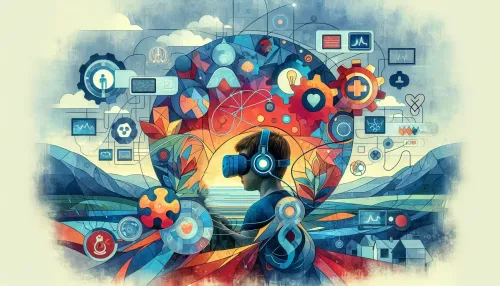Co-Designing Autism Support Apps: Engaging Autistic Users in User Interface Development

Technology has become an integral part of our daily lives, offering immense potential in aiding individuals with autism spectrum disorder (ASD) to navigate their unique challenges. As we delve into the realm of autism support applications, it's paramount to highlight the significance of involving autistic individuals in the design process. Co-designing these apps not only fosters a sense of empowerment but also ensures that the end products are tailored to meet the diverse needs of autistic users, prioritizing user experience and accessibility. This approach amplifies the impact of autism support technology, ushering in a new era of personalized interventions for individuals on the autism spectrum.
Involving Autistic Individuals in the Design Process of Autism Support Applications
Engaging autistic individuals in the design process is pivotal to creating applications that genuinely resonate with their experiences and needs. By adopting a co-design approach, we can harness the invaluable insights and perspectives of autistic users, steering the development of autism support apps towards greater inclusivity and effectiveness.
Embracing Diverse Perspectives
Incorporating the input of autistic individuals at every stage of app development leads to a more comprehensive understanding of their unique challenges and preferences. This collaborative approach enables designers to gain profound insights into the specific needs and sensitivities of autistic users, ensuring that the resulting applications are not just supportive but truly reflective of their experiences.
Related Article: Autism's Secret Edge in Cybersecurity Innovation
Fostering Empowerment and Ownership
By involving autistic individuals in the design process, we empower them to play an active role in shaping tools that directly impact their lives. This fosters a sense of ownership and pride, as they witness their inputs being translated into meaningful features within the applications, thereby promoting a deeper sense of connection and trust between the users and the technology designed to assist them.
Prioritizing User Experience and Accessibility in App Development through Co-Design Methods
Co-design methods prioritize user experience and accessibility, essential components in the development of effective autism support applications. These methods align with our commitment to creating technology that not only meets the functional requirements but also resonates with the lived experiences of autistic individuals.
Related Article: Autistic Minds Shaping the Future of Video Game Design
Tailoring Interfaces for Varied Sensory Needs
Autistic individuals often have distinctive sensory profiles, requiring interfaces that accommodate diverse preferences for visual, auditory, and tactile stimuli. By engaging them in the design process, we can tailor interfaces to align with these sensory diversities, enhancing usability and minimizing sensory overload.
Enhancing Intuitive Navigation and Flexibility
The co-design process allows for the creation of intuitive navigation systems that cater to the cognitive strengths and preferences of autistic users. Additionally, flexibility in customization features can be integrated, enabling users to personalize their app experiences based on their unique requirements and comfort levels.
Related Article: Navigating New Horizons: The Role of Augmented Reality in Developing Social Skills for Autistic Children
Amplifying the Impact of Autism Support Technology through User-Centered Design Approaches
User-centered design approaches amplify the impact of autism support technology by ensuring that these applications are not only functional but also genuinely meaningful and effective in addressing specific challenges faced by autistic individuals.
Incorporating Real-Time Feedback Mechanisms
The co-design approach facilitates the incorporation of real-time feedback mechanisms within the applications, enabling autistic users to provide ongoing evaluations regarding usability, effectiveness, and overall experience. This iterative process ensures that the apps remain responsive to evolving needs and preferences.
Related Article: The Revolution of Augmented Reality in Autism Education
Cultivating Collaborative Communities
By involving autistic individuals in the design phase, we foster collaborative communities where mutual learning and understanding thrive. This inclusive environment imbues a sense of belonging among users as they witness their contributions shaping technology geared towards enhancing their lives.
Empowering Autistic Voices in Shaping Technology for Personalized Autism Interventions
Empowering autistic voices in shaping technology for personalized autism interventions is at the crux of co-designing autism support apps. This approach stands as a testament to our commitment towards creating solutions that not only acknowledge but also celebrate the agency and dignity of autistic individuals.
Related Article: Empowering Through Technology: Success Stories in Autism Education
Cultivating Trust through Transparency
Incorporating autistic voices engenders trust by bringing transparency to the design process. It communicates a profound message; their insights are valued, respected, and crucial in crafting technologies that genuinely serve their needs.
Driving Personalized Interventions through User-Led Innovation
The co-creation of technology aligns with user-led innovation principles, wherein autistic individuals drive personalized interventions by actively contributing their lived experiences and expertise. This user-centric innovation fosters an environment where solutions are born from genuine empathy and firsthand knowledge.
In conclusion, embracing co-design methods when developing autism support applications not only enhances usability but also empowers autistic individuals by amplifying their voices within technology creation. By prioritizing user experience, fostering collaborative environments, and driving user-centered design approaches, we can collectively work towards crafting inclusive technologies that authentically resonate with the lived experiences of those on the autism spectrum. HorizonsMind Blog
Frequently Asked Questions
Involving autistic individuals in the design process is crucial as it ensures that the applications genuinely reflect their experiences and needs. This co-design approach allows designers to gain valuable insights into the unique challenges faced by autistic users, leading to more effective and inclusive technology tailored to their specific requirements.
Co-design methods enhance user experience by prioritizing accessibility and usability tailored to the sensory profiles of autistic individuals. By engaging users in the design process, developers can create intuitive navigation systems and customizable features that cater to diverse preferences, ultimately improving the overall effectiveness of the applications.
User-led innovation plays a vital role in developing personalized autism interventions by allowing autistic individuals to actively contribute their lived experiences. This collaboration fosters empathy-driven solutions that address specific needs, ensuring that technology not only serves functional purposes but also resonates meaningfully with users' daily lives.
Check Out These Related Articles

The Impact of User-Generated Content in Autism Support: A Crowdsourced Approach to Enriching Care Practices

Illuminating Futures: AI-Powered Diagnostics Transform Autism Early Detection

Simplifying the World of Wearable Tech for Autistic Children
